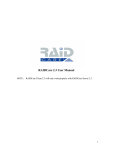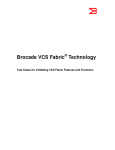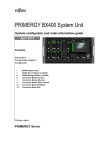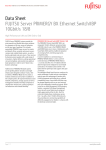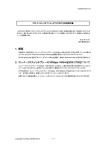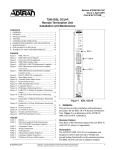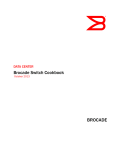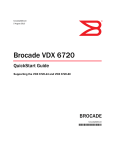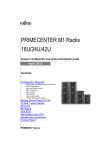Download Brocade Communications Systems Brocade 8/12c Technical data
Transcript
Brocade Network OS 2.1.1_fuj Release Notes v1.1 September 6, 2012 Document History Document Title Summary of Changes Publication Date Brocade Network OS 2.1.1_fuj Release Notes v1.0 Initial release Aug 27, 2012 Brocade Network OS 2.1.1_fuj Release Notes v1.1 Added comments from Fujitsu Sept 6, 2012 Page 1 Copyright © 2012 Brocade Communications Systems, Inc. All Rights Reserved. Brocade, Brocade Assurance, the B-wing symbol, BigIron, DCX, Fabric OS, FastIron, MLX, NetIron, SAN Health, ServerIron, TurboIron, VCS, and VDX are registered trademarks, and AnyIO, Brocade One, CloudPlex, Effortless Networking, ICX, NET Health, OpenScript, and The Effortless Network are trademarks of Brocade Communications Systems, Inc., in the United States and/or in other countries. Other brands, products, or service names mentioned may be trademarks of their respective owners. Notice: The information in this document is provided “AS IS,” without warranty of any kind, including, without limitation, any implied warranty of merchantability, noninfringement or fitness for a particular purpose. Disclosure of information in this material in no way grants a recipient any rights under Brocade's patents, copyrights, trade secrets or other intellectual property rights. Brocade reserves the right to make changes to this document at any time, without notice, and assumes no responsibility for its use. The authors and Brocade Communications Systems, Inc. shall have no liability or responsibility to any person or entity with respect to any loss, cost, liability, or damages arising from the information contained in this book or the computer programs that accompany it. Notice: The product described by this document may contain “open source” software covered by the GNU General Public License or other open source license agreements. To find-out which open source software is included in Brocade products, view the licensing terms applicable to the open source software, and obtain a copy of the programming source code, please visit http://www.brocade.com/support/oscd. Export of technical data contained in this document may require an export license from the United States Government. Page 2 Contents Overview ...................................................................................................................................................... 5 Descriptions of Key NOS Features ........................................................................................................... 5 VDX 2730 ...................................................................................................................................................... 6 Hardware Feature Descriptions .............................................................................................................................. 6 NOS Feature Description ......................................................................................................................................... 7 Summary of New Features and Enhancements .................................................................................................... 8 New Features ............................................................................................................................................... 9 VCS Fabric to FC SAN Connectivity ......................................................................................................................... 9 Edge Loop Detection (ELD) ..................................................................................................................................... 9 Configurable Tail Drop Threshold ........................................................................................................................... 9 New Enhancements and Support ............................................................................................................ 10 Support for USR Optics .......................................................................................................................................... 10 VLAG support ......................................................................................................................................................... 10 VM-Aware Network Automation with vSphere 5.0 ............................................................................................... 10 VM-Aware Network Automation with 8000 MAC Addresses ............................................................................... 10 Miscellaneous Enhancements .............................................................................................................................. 10 Optional Licensed Software ..................................................................................................................... 10 Standards, Compatibility, Interoperability, and Scalability .................................................................. 11 Standards Compliance .......................................................................................................................................... 11 Scalability ............................................................................................................................................................... 12 Technical Support ..................................................................................................................................... 13 Documentation Updates ........................................................................................................................... 14 Reporting Errors in the Guides ............................................................................................................... 14 Contacting Brocade .................................................................................................................................. 14 Compatibility ............................................................................................................................................. 15 Firmware Upgrade and Downgrades ...................................................................................................... 16 Important Notes ......................................................................................................................................... 17 Command Line Interface (CLI) .............................................................................................................................. 17 MAC Learning Considerations in VCS ................................................................................................................... 17 Trunking ................................................................................................................................................................. 17 Span ....................................................................................................................................................................... 17 AMPP and Port Profiles.......................................................................................................................................... 17 Security, ACLs, Authentication, Authorization ...................................................................................................... 18 Virtual IP Address Support .................................................................................................................................... 18 Miscellaneous ........................................................................................................................................................ 18 Known Issues ............................................................................................................................................ 20 Page 3 APPENDIX A .............................................................................................................................................. 21 Show enclosure...................................................................................................................................................... 21 Page 4 Overview Brocade NOS 2.1.1_fuj is the platform-specific release that supports the VDX 2730 Connection Blade for the Fujitsu BX900 and BX400 Blade Server. Other than the expectations noted in this document, this software release is functionally similar to NOS 2.1.1. Release NOS 2.1.1_fuj is based on Brocade Network Operating System (NOS) v2.1.1, which provides the basis for Brocade VCS™ technology that runs on Brocade VDX™ switches. Brocade Network OS is the revolutionary genesis of two decades of engineering development, combining the strengths of Brocade’s datacenter SAN and LAN platforms. It enables building private cloud datacenters that are robust, simplified, and scalable. Warning: a) Do not load NOS 2.1.1 or other non-supported NOS releases on the VDX 2730. Note that NOS 2.1.1_fuj is a special release that supports the VDX 2730. b) NOS 2.1.1_fuj is only supported for VDX 2730. Do not load this release on any other switch platform. Descriptions of Key NOS Features VCS Technology Brocade VCS technology is a revolutionary Layer 2 (L2) Ethernet technology that raises network utilization, increases application availability, enhances system scalability, and drastically simplifies the data center network architecture. Based on the concept of Ethernet fabric, distributed intelligence, and logical chassis, the architecture will be further extended over time with new services and capabilities, providing Brocade customers with the highest level of investment protection. Brocade Trunking A Brocade Trunk is a hardware-based link aggregation group. Brocade trunks are dynamically formed between two adjacent switches. The trunk formation, which is not driven by LACP, is instead controlled by the same FC trunking protocol that controls the trunk formation on FC switches operating with Brocade Fabric Operating System. On connecting links between two adjacent Brocade VDX switches, Brocade trunks are enabled automatically, without requiring any additional configuration. Brocade trunking operates at Layer 1 (L1) and is a vastly superior technology when compared to software-based hashing used in standard LAG that operates at L2. It evenly distributes traffic across the member links on a frame-by-frame basis without the need for hashing algorithms, and can co-exist with standard IEEE 802.3ad LAGs. Multi-Chassis Trunking (MCT) and Virtual LAG (vLAG) Multi-Chassis Trunking (MCT) is an industry-accepted solution that is used to avoid spanning tree in L2 topologies. Link Aggregation Group (LAG) based MCT is a special case of LAG covered in IEEE 802.3ad, in which the LAG ends terminate on two separate chassis that are directly connected to each other. Virtual LAG (vLAG), a Brocade innovation, further extends the concept of LAG by allowing its formation across two physical switches that may not be directly connected to each other (but participate in the same VCS fabric). Automatic Migration of Port Profiles (AMPP) Automatic Migration of Port Profile (AMPP) functionality provides fabric-wide configuration of Ethernet policies, achieves per-port profile forwarding, and enables network-level features to support VM mobility. AMPP bridges the gap between existing server virtualization infrastructures and L2 switching capabilities by providing a mechanism for migrating the port profile resident in a switch and associated with an OS image, to a different port or switch when that OS image migrates from one server to another. Fibre Channel over Ethernet (FCoE) Network OS (NOS) has an FCoE processing stack and is capable of processing FIP logins. NOS switches enable a multi-hop FCoE use case when connected in a VCS cluster. FCoE-to-FC bridging is also enabled by NOS when FC ports are present on the switch, such as in the VDX 2730. Page 5 VDX 2730 The Brocade VDX 2730 10GbE Connection Blade for the Fujitsu PRIMERGY BX900 and BX400 Blade Servers is a 10 Gbps Ethernet Data Center Bridging (DCB) embedded switch module that provides six external native 8-Gbps or 4-Gbps Fibre Channel (FC) ports, and six external 10-Gbps Ethernet ports, allowing you to combine storage and network traffic on a single network. The Brocade VDX 2730 also provides 18 internal 10GBASE-KR ports with DCB support that connects to the Fujitsu PRIMERGY BX Blade Servers by way of a passive midplane. 1. Port LED (one for each port) 4. Reset button 2. Release lever 5. Six 10-Gbps Ethernet ports 3. System LEDs 6. Six 8-Gbps FC ports Hardware Feature Descriptions The VDX 2730 is custom-designed for the Fujitsu PRIMERGY blade server chassis. The following hardwarespecific features are related to this module. • Six external Data Center Bridging (DCB) ports provide device or additional switch connections at 10 Gbps. • Eighteen internal 10GBASE-KR ports are provided that support DCB. • Six external FC ports can be used for Brocade fabric connections at 4 Gbps or 8 Gbps using SFP (4 Gbps) or SFP+ (8 Gbps) fiber-optic transceivers. • Auto-sensing capabilities detect 4-Gbps or 8-Gbps SAN switches. • Transceivers for FC ports Short-wavelength (SWL) and long-wavelength (LWL) SFP and SFP+ transceivers (4 Gbps and 8 Gbps respectively) for fiber-optic capabilities are supported. • Transceivers for Ethernet ports • Ultra-short-range (USR), short-range (SR), and long-range (LR) SFP+ transceivers (10 Gbps) for Ethernet and Fiber Channel over Ethernet (FCoE) capabilities are supported. • Brocade active twinaxial (TWX) cables (1, 3, and 5 meters) are supported. • Multi-Mode Fibre (MMF) at the FC and Ethernet ports and Single-Mode Fibre (SMF up to 10 km) modules are supported. Page 6 • One internal I2C connection to the PRIMERGY BX Management Blade provides control and status collection. • One internal serial port (RS-232) connection to the PRIMERGY BX Management Blade provides switch control. • Two internal 10/100 Mbps Ethernet interfaces over the midplane to the Management Blade support switch management. • Port status LEDS indicate status of the ports, and system status LEDs indicate UID, health, and module status using color indicators and patterns. • Power-on self-test (POST) and embedded online and offline diagnostics are supported. • Dual temperature sensors maintain internal temperatures. • Switch power consumption is monitored and a power-saving feature is implemented when FC ports are not enabled. • As with all Fibre Channel devices, operates in switch mode. NOS Feature Description All features of NOS 2.1.1 release are supported on VDX 2730 except where noted in this document. Network OS v2.1.1 includes the following high-level features: Layer 2 Security Features • VLANs • Cisco PVLAN • Spanning Tree Protocol (STP, RSTP, MSTP and PVST+ and PVRST+) • Unicast and multicast capabilities • IGMP snooping • Layer 2 Forwarding • Layer 2 multi-path based on Transparent Interconnection of Lots of Links (TRILL) • Layer 2 access control lists (VLAN ACL and Port/Interface ACL) • Management-access ACLs • Switch Port Analyzer (SPAN) (also known as port mirroring) • Brocade VCS Ethernet Fabric technology • Transparent mode with single-node VCS Virtualization • Automatic Migration of Port Profiles (AMPP) • VLAN, QoS, and security port profiles • Virtual Machine-aware network automation Convergence • Pause Frames (Tx and Rx) • DCB features such as Priority Flow Control (PFC) and Enhanced Transmission Selection (ETS) • End-to-end, multi-hop FCoE • FCoE and FC zoning and Registered State Change Notification (RSCN) suppression (name serverbased zoning) • FC connectivity to Brocade FC SANs and by Brocade Fibre Channel Routing (FCR) Page 7 Link Aggregation • Port channel 802.3ad providing Link Aggregation Control Protocol (LACP) and static support • Virtual Link Aggregation Group (vLAG) (a LAG that spans multiple physical switches) • QoS • 802.1x and 802.1p marking • Link Layer Discover Protocol (LLDP) and Data Center Bridging Exchange (DCBX) support • iSCSI DCBX support • Strict priority (SP) and Shaped Deficit Weighted Round-Robin (SDWRR) scheduling Management • IPv4 and IPv6 for management and data flow, dual stack • TACACS+, RADIUS, and Lightweight Directory Access Protocol (LDAP) authentication for user management • CLI management utilities on Network OS • Brocade Network Advisor (ver 11.3) for Web-based GUI used for configuration and switch management • Command-line interface (CLI) that offers flexible, remote switch management using a Telnet connection or SSH • Fujitsu Management Blade or Brocade Web Tools • sFlow for network traffic monitoring • TRILL Operations, Administration, and Management (OAM) • Distributed configuration management (DCM) • SNMPv1, v2c, and v3 • SNMP MIBs common to standard switches (as described in the Network OS MIB Reference) • Switch Beaconing • Switched Port Analyzer (SPAN) • MAC learning and aging • MAC learning on uplink ports to support many MAC addresses • VCS license—Enables VCS clustering. A two-node VCS can be created without requiring a VCS license; however, creation of a VCS cluster beyond two nodes requires a VCS license on all nodes in the cluster. • SNMP and Netconf to provide easy access to switch information Summary of New Features and Enhancements NOS v2.1.1 includes the following new features: • VCS fabric to FC SAN Connectivity • Edge Loop Detection (ELD) • Configurable Tail Drop Threshold NOS v2.1.1 also includes the following new enhancements and support: • Support for Ultra Short Range optics • VM-Aware Network Automation support with vSphere 5.0 Page 8 • VM-Aware Network Automation with 8000 MAC Addresses • VLAGs with 32 ports New Features VCS Fabric to FC SAN Connectivity A VDX 2730 running NOS v2.1.1_fuj can form an Inter Fabric Link (IFL) by connecting to an EX-port on most Brocade 8-Gbps or 16-Gbps FC platforms operating FOS v7.0.1 or later. In most common deployment scenarios, a VDX 2730 connects directly to an FCR “backbone” fabric (an FC fabric with a switch acting as a Fibre Channel Router, or FCR). As an alternative, the VDX 2730 can form a VCS fabric with the VDX 6730 (NOS 2.1.1), allowing multi-hop FCoE traffic originating from VDX 2730 connected blade servers to bridge to FC ports on the VDX 6730. The following table provides interoperability information and minimum firmware versions required for NOS and FOS platforms. VDX Platforms/NOS Firmware Versions VDX 2730/NOS v2.1.1_fuj or later FCPlatforms1/FOS Firmware Versions Brocade DCX/DCX-4S/DCX8510-8/ DCX8510-4/6510/5300/5100/ VA-40FC/7800 All platforms forming an IFL connection to a VCS fabric must be operating with FOS v7.0.1 (or later) FOS Firmware Version on Switches in FC Backbone or Edge Fabrics Please refer to the FOS v7.0.1 release notes for the complete interoperability matrix. 1 Other Brocade FC platforms support FOS v7.0.1 and FCR/Integrated Routing functionality; however, those platforms are not supported for interoperability with VDX platforms when using FOS v7.0.1. Edge Loop Detection (ELD) NOS v2.1.1_fuj supports Edge Loop Detection (ELD), a protocol that detects a loop by shutting down ports when it receives its own PDU. ELD is primarily used to detect L2 loops due to bad configuration, malformed physical connections, and other user errors. ELD is supported only in VCS mode. ELD should NOT be treated as a substitute for L2 loop prevention protocols such as STP, MSTP, RSTP, etc. Configurable Tail Drop Threshold User-configurable CoS Tail Drop Thresholds are supported in NOS v2.1.1_fuj. This feature allows you to configure Tail Drop Threshold on a physical interface. When the configurable threshold levels for a given traffic class (CoS) are exceeded, the packets for that traffic class get tail-dropped. Allowing user-configurable thresholds provides the flexibility to assign more buffers to certain traffic classes over others. A traffic class with deep buffers will encounter fewer tail drops. Page 9 New Enhancements and Support Support for USR Optics NOS v2.1.1_fuj supports Ultra Short Range (USR) optics. Please refer to the Brocade VDX 2730 10GbE Connection Blade for the Fujitsu PRIMERGY BX900 and BX400 Blade Servers hardware Reference Manual for actual part numbers. VLAG support VLAG is supported on internal as well as external Ethernet ports. VM-Aware Network Automation with vSphere 5.0 The VM-Aware Network Automation feature is validated with VMware vSphere 5.0 in NOS v2.1.1_fuj. Network OS doesn’t enforce any specific VMware vSphere license requirements to interoperate. VM-Aware Network Automation with 8000 MAC Addresses In NOS 2.1.1_fuj, the VM-Aware Network Automation feature is enhanced to support 8000 VM MAC addresses. VM-Aware Network Automation is now capable of detecting up to 8000 VM MACs and support VM mobility of this scale within a VCS fabric. Miscellaneous Enhancements SNMP MIB Support for Fibre Channel ports has been added in NOS v2.1.1_fuj. Two new supported traps include swStateChangeTrap and swFCPortScn. FC counters are also supported in NOS v2.1.1_fuj. NETCONF is now supported for Fibre Channel interfaces. Optional Licensed Software The VDX 2730 has two base SKUs ( SKU SM-VDX2730-0000) that enable 24-port 10G Ethernet configuration. FCoE/FC and VCS capabilities can be enabled on the base SKU by adding software licenses, which are noted below. • FCoE license: Offers FC and Fibre Channel over Ethernet (FCoE) support. An FCoE license enables six external FC ports and FCoE functionality. FC ports support auto-sensing (which negotiates to the highest speed that is supported by the attached device), WWN-based soft zoning, and trunking. Multi-hop FCoE requires an Ethernet fabric that is enabled with a VCS license. As a result, both license upgrades (FCoE and VCS) are required. • VCS license: Enables VCS clustering. A two-node VCS can be created without requiring any license but creation of a VCS cluster beyond two nodes requires a VCS license on all nodes in the cluster. Software Licenses SKUs Software License SKU Description SM-VDX-EMBD-VCS-01 VCS license SM-VDX-EMBD-FCOE-01 FCoE license Note: All licenses include 13 month ‘–M’ support. Page 10 The VDX 2730 also has an enterprise SKU SM-VDX2730-0001 that enables 24-port 10G Ethernet ports, FCoE/FC and VCS capabilities in the same SKU. Standards, Compatibility, Interoperability, and Scalability Standards Compliance This software generally conforms to Ethernet standards in a manner consistent with accepted engineering practices and procedures. In certain cases, Brocade might add proprietary supplemental functions to those specified in the standards, or choose to implement modifications to the standards for performance or behavioral improvements. The VDX products conform to the following Ethernet standards: • • • • • • • • • • IEEE 802.1D IEEE 802.1s IEEE 802.1w IEEE 802.3ad IEEE 802.3ae IEEE 802.1Q IEEE 802.1p IEEE 802.1v IEEE 802.1AB IEEE 802.3x Spanning Tree Protocol Multiple Spanning Tree Rapid reconfiguration of Spanning Tree Protocol Link Aggregation with LACP 10G Ethernet VLAN Tagging Class of Service Prioritization and Tagging VLAN Classification by Protocol and Port Link Layer Discovery Protocol (LLDP) Flow Control (Pause Frames) The following draft versions of the Data Center Bridging (DCB) and Fibre Channel over Ethernet (FCoE) Standards are also supported on VDX products: • • • IEEE 802.1Qbb IEEE 802.1Qaz IEEE 802.1 • FC-BB-5 Priority-based Flow Control Enhanced Transmission Selection DCB Capability Exchange Protocol (Proposed under the DCB Task Group of IEEE 802.1 Working Group) FCoE (Rev 2.0) The VDX products conform to the following Internet IETF RFCs: • • • • • • • • RFC 2865 RFC 1112 RFC 2236 RFC2131 RFC 2571 RFC 3176 RFC 1157 RFC4510 Remote Authentication Dial In User Service (RADIUS) IGMP IGMPv2 DHCP Architecture for Describing SNMP Framework sFlow SNMPv1/v2c Lightweight Directory Access Protocol (LDAP) Page 11 Scalability All scalability limits are subject to change. Limits may be increased once further testing has been completed, even after the release of a particular Network OS version. The limits noted in this table are derived from the NOS_2.1.1 release notes. NOS Scalability Limits Maximum # of VLANs Standalone Switch VCS Fabric 2000 2000 30,000 30,000 256 256 8 8 Maximum # of L2 multicast group 2000 2000 Maximum # VLAN per Edge Port in Trunk Mode 750 750 N/A 60 Maximum # of FCoE Devices per Fabric N/A 3000 Maximum # of FCoE Logins N/A 1000 Maximum # of MSTP instance 32 N/A 60 N/A Maximum # of members in a standard LAG 16 N/A Maximum # of members in a Brocade LAG 8 8 Maximum # of switches in a Fabric N/A 24 Maximum # of ECMP Paths N/A 8 Maximum # of VLAG groups N/A 512 Maximum # of member ports in a VLAG N/A 32 Maximum # of nodes in a VLAG N/A 4 200m 200m Maximum # of MAC addresses Maximum # of port profiles(AMPP) Maximum # of per priority pause levels Maximum # of FCoE interfaces (Platform Dependent) Maximum # of LAG groups (Platform dependent) Maximum cable length for lossless connectivity Page 12 NOS Scalability Limits Standalone Switch VCS Fabric Maximum size of Zoning Database (in bytes) N/A 150K Maximum # of Management ACL 256 256 Maximum # of VMs supported in VM Aware Network Automation 8000 8000 Technical Support Contact your switch supplier for hardware, firmware, and software support, including product repairs and part ordering. To expedite your call, have the following information available: 1. General Information • Switch model number • Switch operating system version • Switch serial number • Technical Support contract number, if applicable • Error numbers and messages received • Provide support data collection output with the copy support command • Detailed description of the problem, including the switch or fabric behavior immediately following the problem, and specific questions • Description of any troubleshooting steps already performed and the results • Serial console and Telnet session logs • Syslog message logs 2. Switch Serial Number The switch serial number and corresponding bar code are provided on the serial number label as illustrated below: The serial number label is located on the bottom of the module. Page 13 Documentation Updates For detailed NOS documentation refer to NOS 2.1.1 release notes. When using the NOS 2.1.1 documentation, the VDX 2730 is equivalent to the VDX 6720 except where noted in this section. Refer to www.brocade.com or my.brocade.com http://my.brocade.com/ for the latest versions of the documents. The following three NOS 2.1.1 documents are recommended references: • Network OS Administrator Guide Part # 53-1002491-01 • Network OS MIB Reference Part # 53-1002490-01 • Network OS Command Reference Part # 53-1002492-01 The VDX 2730 uses commands in addition to the ones listed in the Network OS Command Reference. Refer to Appendix A for the additional commands. Reporting Errors in the Guides Quality is our first concern at Brocade and we have made every effort to ensure the accuracy and completeness of this document. However, if you find an error or an omission, or you think that a topic needs further development, we want to hear from you. Forward your feedback to: [email protected] Provide the title and version number of the document and as much detail as possible about your comment, including the topic heading and page number and your suggestions for improvement. Contacting Brocade To contact Brocade, go to http://www.brocade.com/services-support/index.page for the latest e-mail and telephone contact information. Page 14 Compatibility The following tables list the interoperability matrix with Brocade and non-Brocade parts. The tested software versions on the parts are also provided in the table. For Brocade parts, it is recommended that you use the latest software versions to get the best benefits. Latest information on the effective end-of-life dates for all versions of software (NOS or FOS) is available on the Brocade website at: http://my.brocade.com SUPPORTED SWITCH SOFTWARE RELEASE BROCADE BR8000 v7.0.0a VDX6720-60 V2.1.1 VDX6720-24 V2.1.1 VDX6730-60 V2.1.1 Other Vendor Cisco Nexus 5000 v4.1(3)N2(1a) BX900 CHASSIS SUPPORT Server Blade Type OS Type C.N.A Windows Server 2008 R2, Windows Server 2003 SP1 64-Bit, Emulex BE3-based mezz card MC-CNA112E BX924 S2 VMware ESX 4.1, RedHat EL 6.1 64-bit BX960 S1 RedHat EL 6.1 64-bit, Windows Server 2008 R2 BX920 S3 RedHat EL 6.1 64-bit, Windows Server 2008 R2 BX924 S3 Windows Server 2008 R2 Windows Server 2008 R2, Windows Server 2003 SP1 64-Bit, Emulex BE2-based mezz card MC-CNA102E BX924 S2 VMware ESX 4.1, RedHat EL 6.1 64-bit BX960 S1 RedHat EL 6.1 64-bit, Windows Server 2008 R2 BX920 S3 RedHat EL 6.1 64-bit, Windows Server 2008 R2 BX924 S3 Windows Server 2008 R2 Windows Server 2008 R2, Windows Server 2003 SP1 64-Bit, *Intel Niantic-based mezz card MC-I599 BX924 S2 VMware ESX 4.1, RedHat EL 6.1 64-bit BX960 S1 RedHat EL 6.1 64-bit, Windows Server 2008 R2 Page 15 LOM RedHat EL 6.1 64-bit, Windows Server 2008 R2, BX920 S3 Windows Server 2003 SP1 64-Bit RedHat EL 6.1 64-bit, Windows Server 2008 R2, BX924 S3 Windows Server 2003 SP1 64-Bit BX960 S1 RedHat EL 6.1 64-bit, Windows Server 2008 R2 *Intel Niantic-based LOM BX924 S2 Emulex BE3-based LOM BX400 CHASSIS SUPPORT Server Blade Type OS Type BX920 S3 RedHat EL 6.1 64-bit, Windows Server 2008 R2 BX924 S3 RedHat EL 6.1 64-bit, Windows Server 2008 R2 BX924 S2 RedHat EL 6.1 64-bit, Windows Server 2003 SP1 64-Bit BX920 S3 RedHat EL 6.1 64-bit, Windows Server 2008 R2 BX924 S3 RedHat EL 6.1 64-bit, Windows Server 2008 R2 BX924 S2 RedHat EL 6.1 64-bit, Windows Server 2003 SP1 64-Bit BX920 S3 RedHat EL 6.1 64-bit, Windows Server 2008 R2 BX924 S3 RedHat EL 6.1 64-bit, Windows Server 2008 R2 BX920 S3 RedHat EL 6.1 64-bit, Windows Server 2008 R2 Emulex BE3-based LOM BX924 S3 RedHat EL 6.1 64-bit, Windows Server 2008 R2 *Intel Niantic-based LOM BX924 S2 RedHat EL 6.1 64-bit, Windows Server 2003 SP1 64-Bit C.N.A Emulex BE3-based mezz card MC-CNA112E Emulex BE2-based mezz card MC-CNA102E *Intel Niantic-based mezz card MC-I599 LOM * Intel Niantic based server interface is not supported in NOS 2.1.1_fuj Firmware Upgrade and Downgrades NOS 2.1.1_fuj is the first release of this product. Upgrades and downgrade of the firmware are not applicable at this time. Page 16 Important Notes This section contains information that you should consider before you use this Network OS release. This information is derived from NOS 2.1.1 release notes. Command Line Interface (CLI) • Some commands will not produce paginated output. • For certain commands (including the no form with some commands), “?” will show unsupported additional options. • Tab completion and <ctrl>-c (cancel) does not work for some commands. • For some commands, “switchId” and “all” options are not applicable in this NOS release but are still shown as options. These will be applicable and supported in future NOS releases. • Some CLI commands will generate an “Error:Access denied” message upon failure. This means the operation failed on the switch and may not be related to permissions. • The no command always exists for all roles, even if it is not required. • Some no commands will execute without mandatory parameters that were originally used for configuration. • Some no commands may produce an incorrect error message upon error. • An incorrect range might be displayed in the help text for some of the show commands. MAC Learning Considerations in VCS • The clear mac-address-table command has been enhanced to support clearing of the mac addresses associated with vLAGs. This command can be used to sync mac address tables of the VCS member switches. Trunking • Brocade trunk (BTRUNK) has a maximum throughput of 80 Mbps. Full link utilization of 8 ports in a trunk group is achievable with larger packet size (>128 bytes). Span • CPU-originated packets cannot be output spanned on the VDX 2730. • Span is supported only within a port group on the VDX 2730. • A port cannot be spanned to multiple locations in the same direction. • Only one port per port group can be configured as a destination port for ingress spanning. • Only one port per port group can be configured as a destination port for egress spanning. • An ISL port cannot be a source or destination SPAN port. • Inter-chip port spanning is not allowed. • Spanning of a LAG port is not supported. To span a LAG, you should individually enable spanning on all the member ports of the LAG. • A profiled port cannot be a span destination. AMPP and Port Profiles • Port profile status does not reflect the remote interface information in VCS fabric mode. • AMPP is recommended to be enabled on ports in which end-hosts are directly connected to the VDX 2730 cluster. • Native VLAN support inside AMPP does not honor the global enable or disable flag. Page 17 • A SPAN destination port cannot be a profiled port. • All AMPP features that were supported only on a physical interface on NOS v2.0 are now supported on a VLAG in NOS v2.1, with the exception of FCoE sub-profile, which is not supported in LAG/VLAG mode. • While migrating from a legacy AMPP environment to VM Aware Network Automation, it is recommend that you delete all manually created port profiles to facilitate smooth migration. Security, ACLs, Authentication, Authorization • ACLs are not supported for egress traffic flows. • Configuring TACACS+ or RADIUS without a key is not supported. If no key is configured, the switch uses a default key of “sharedsecret.” • There is a possibility that locked user accounts will get unlocked after a reboot if the runningconfig (before reboot) is different from the startup-config of user accounts. • Encrypted text (taken from running-config of any user account password with encryption turned on) should not be used as input for a clear-text password for the same user. This may result in subsequent login failure of the user. • There is no upper limit for the number of rules that can be added to a management access-list. However, when the ACL is applied to a management interface, only the top 256 rules will be applied if the ACL contains more than 256 rules. • Access to ONLY the following Active Directory (AD) servers is supported by Brocade LDAP client: o Windows 2000 o Windows 2003 o Windows 2008 AD Virtual IP Address Support • A Virtual IP address cannot be configured on a standalone node in VCS mode. • A separate gateway cannot be configured for a Virtual IP address. The default gateway will be the same as the gateway address for the management port of this switch. • There is no Virtual MAC address associated with the Virtual IP address. • For Virtual IP address to work correctly, the IPv4 address of the management port should be assigned and functional. Miscellaneous • Brocade VDX switches load balance internal and external traffic based on hash functions using standard network headers as keys. Due to this implementation, you may experience a traffic imbalance depending on the application flow definition. • Packet drops will be seen for a short duration due to routing changes with link flaps and/or node failovers. • Priority 7 is reserved for control traffic on VDX switches. User data traffic should use priorities 0 through 6. • Brocade VDX architecture prioritizes unicast traffic over Broadcast or multicast traffic under port congestion. • System verification or diagnostics performed on a switch will require a reboot. • Flow control is disabled by default on all interfaces. • Configuration of more than one in-band management port on a single switch is not recommended. • Even though the IGMP snooping feature is supported over VLAG, all multicast data traffic will be forwarded only over the primary. Page 18 • On both ISL and Edge ports, sFlow sampling is supported only in the inbound direction. • The DNS configuration is primarily used for LDAP. It should be noted that DNS look-up will not be used by PING, Traceroute, or any other services. These services will still require specifying the actual IP address. • VM-Aware Network Automation will work only with VMware vSphere version 4.0, 4.1 and 5.0. • Enabling VM-Aware Network Automation will cause the Brocade VDX switch to drop CDP packets. • Any local loop, even within a single fabric, can cause broadcast storms and potentially impact the entire network. A local loop in one fabric may impact another fabric in the case of VCS-to-VCS fabric connectivity. Using ELD to prevent loops is highly recommended. • When ELD is enabled, toggling global or interface-level native VLAN tag mode can cause ELD not to function as expected on that VLAN. It is not recommended to make such changes after ELD is enabled; however, in the event that this occurs, disable and then enable ELD to resume proper functionality. • If multiple VLANs are configured on a switch, in order to enable certain features such as IGMP or PVST, it is recommended that specific features be enabled on a per-VLAN basis instead of enabling them globally. • When a new switch is added to an existing VCS fabric and if the new switch takes the role of principal node, the other switches in the fabric will receive the configuration of the distributed features such as Virtual IP and VM-Aware Network Automation from the newly added switch. This will cause the existing distributed configuration to be overwritten by the newly added switch in the principal role. • When interoperating with a Brocade 8000, it is recommended to set the mac-aging time to 0 on the VDX switch to prevent any adverse impact caused by certain errors generated by the Brocade 8000. • When configuring LACP LAG between a Brocade VDX switch and non-Brocade switches, it is highly recommended that you enable the VLAG ignore-split on the Brocade VDX switch. The ignore-split option is enabled by default in NOS v2.1. • When a MAC ACL with several clauses is applied to a port channel that is a member of 750 or more VLANS, the MAC ACL counters may take several minutes to be enabled due to the processing load associated with such configurations. • It is recommended that you use the same CoS Tail Drop Threshold on all members of a port channel to avoid unpredictable behavior. • Under certain stress conditions, the copy support command may time out for some modules. In such cases, it is recommended that you retry copy support with a higher timeout multiplier value. • It is highly recommended that you copy the configuration file to running-config and then save the running-config to startup-config, instead of directly copying the external configuration file to startup-config, especially when using fabric-distributed features such as zoning, VM-Aware Network Automation, and Virtual IP. • It is not recommend to have FCoE ports and Long Distance ISL ports in the same port groups. This configuration will NOT be prevented by the CLI; however it can result in unpredictable behavior for FCoE traffic. • Brocade VDX switches do not support tunneling non-standard BPDUs and thus IEEE BPDUs (0180:C200:0000) generated as tagged packets in STP/RSTP/MSTP modes may not be tunneled successfully across a VCS fabric. However, Brocade VDX switches support tunneling standardsbased BPDUs such as untagged IEEE BPDUs, and tagged or untagged PVST BPDUs (0100:0CCC:CCCD). • When configuring a large ACL and VLAN configuration on a single physical interface or port channel, it may take up to 20 minutes for the ACL statistics counter to start counting packets. Page 19 • Critical NOS services may terminate, resulting in a switch reboot if the switch is loaded with a large number of VLANs configured for "no shutdown." Configuring the switch with all VLAN interfaces set to “shutdown” will prevent this from occurring and will not affect any functionality. • The VCS replace command is not supported on VDX 2730. Known Issues Note: The following features are not supported for this release of VDX 2730: • • Intel Niantic Mezz card and LOM LACP default mode for PXE boot Defect ID: DEFECT000414898 Technical Severity: Medium Summary: ISMIC support for stateless IPv6 addresses is not present. Symptom: ISMIC support for stateless IPv6 addresses is not present. Feature: Embedded Platform Services Function: Other Reported In Release: NOS 2.1.1_fuj Defect ID: DEFECT000389724 Technical Severity: Medium Summary: One member within a vLAG may not not sync up although the port was online. Symptom: In rare cases, one member within a vLAG may not sync up although the port was online Feature: CEE-LAYER2 Function: LAG/TRUNKING Reported In Release: NOS 2.1.1_fuj Probability: Low Defect ID: DEFECT000403990 Technical Severity: Medium Summary: Configuration of User Assigned Name from MMB doesn't sustain across reboot Symptom: Configuration of User Assigned Name from MMB doesn't push down to the switch Feature: Embedded Platform Services Function: Other Reported In Release: NOS 2.1.1_fuj Probability: High Defect ID: DEFECT000405183 Technical Severity: Medium Summary: 'vcs replace' is not supported in NOS 2.1.1_fuj release but will display as an operand Symptom: User will see “Error: Command is not supported as the local node is not in cluster.” , on executing command ‘vcs replace’. Feature: VCS-infra-dcm Reported In Release: NOS 2.1.1_fuj Function: DCM - Other Probability: High Defect ID: DEFECT000406824 Technical Severity: Medium Summary: When an internal port is disabled by the e-keying function with port config "no shut", there is no error message when user attempts to enable it Symptom: When a user attempts to enable an internal port, which has been disabled by e-keying using port config "no shut:" no error message is displayed. Feature: CEE-Protocol Function: NSM Service Request ID: 233447792 Reported In Release: NOS 2.1.1_fuj Probability: High Page 20 APPENDIX A This section details the NOS feature/commands specific to the VDX 2730. Show enclosure Overview Shows the chassis model name and module bay ID in which the switch is inserted. #show enclosure Possible completions: modelname Provides Chassis model name slotid Provides Present Slot Id of switch Page 21






















